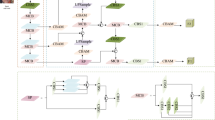Abstract
In order to monitor whether a driver is tired or prone to road rage in real time and avoid some traffic accidents, a real-time detection method of driver's facial expression based on the facial feature point location is proposed. First, we use the AdaBoost face detection algorithm based on Haar characteristics to detect the presence of a face and use the face feature point localization algorithm to obtain the required face feature points. Then, the value of eye aspect ratio is calculated according to the feature point data of the face-eye region, which indicates the opening degree of eyes. The driver is detected whether he (she) is in fatigue driving according to the appropriate threshold. We improve the detection method of fatigue driving and apply it to the road rage detection algorithm. We first propose the ratios of the brow-eye distance and mouth closure (RBEM) as indicators to determine whether the driver has road rage characteristics. Experimental results verify the effectiveness of the method.






















Similar content being viewed by others
References
Toroyan T (2013) Global status report on road safety 2013: supporting a decade of action. Inj Prev 15(4):286–286
Li DH, Liu Q, Yuan W et al (2010) Relationship between fatigue driving and traffic accident. J Traffic and Trans Eng 10(2):104–109
Jin C, Chen G (2018) Emotion recognition of multimodal physiological signals based on optimized LSTSVM. Appl Electron Tech 44(3):112–116
Soares G, Lima DD, Neto AM (2019) A mobile application for driver's drowsiness monitoring based on PERCLOS Estimation. Latin Am Trans. IEEE (Revista IEEE America Latina),
Arnold PK, Hartley LR, Corry A et al (1997) Hours of work, and perceptions of fatigue among truck drivers. Accid Anal Prev 29(4):471–477
Coetzer RC, Hancke GP (2011) Eye detection for a real-time vehicle driver fatigue monitoring system. 2011 IEEE Intelligent Vehicles Symposium (IV) https://doi.org/10.1109/IVS.2011.5940406
Chen X, Luo X, Liu X, Fang J (2019) Eyes localization algorithm based on prior MTCNN face detection. 2019 IEEE 8th Joint International Information Technology and Artificial Intelligence Conference ITAIC. https://doi.org/10.1109/ITAIC.2019.8785430
Peng L, Feng L (2017) Driver’s road rage expression recognition method fusing facial infrared information and depth information. Softw Guide 16(10):198–201
Zhen H (2015) Stay away from road rage. Sci Technol Family 6:38–39
Xianzhong Q, Jianzhong Z (2011) Analysis of road rage from the perspective of bio-psycho-social medicine model. Chinese J Soc Med 4:269–271
Jin J (2015) Road rage needs restraint in traffic civilization. Adolesc Health 12:8–9
Peng L, Feng L (2017) Driver’s road anger expression recognition method fused with facial infrared information and depth information. Softw Guide 16(10):198–201
Yu Lijiao Wu, Zhenxin WW et al (2019) A summary of driver fatigue state monitor system. Autom Dig 03:24–30
Xingwen Z, Lijun H, Enlai G et al (2020) Multi-angle key point detection of face based on deep learning detector. Opto-Electron Eng 47(1):64–71
Viola PA, Jones MJ (2001) Rapid object detection using a boosted cascade of simple features. Computer vision and pattern recognition. CVPR 2001. Proceedings of the 2001 IEEE Computer Society Conference on IEEE, 2001
Lienhart R, Maydt J. (2002) An extended set of Haar-like features for rapid object detection. Proceedings. International Conference on Image Processing IEEE
Pengcheng Y, Yiming Z, Guanghong T et al (2020) Face recognition method in video surveillance based on convolutional neural network. J Chengdu Technol Univ 23(1):26–31
Jiang W, Guo G, Lai Z (2014) An improved adaboost algorithm based on new Haar-like feature for face detection. J Shandong Univ (Eng Sci) 44(2):43–48
Liu L, Wu S, Xu W (2018) Real-time fatigue driving detection based on analysis of facial landmarks. Video Eng, 42(12): 27–30+55
Soukupová Č (2016) Eye-blink detection using facial landmarks [D]. Czech Technical University, 2016
Acknowledgements
This work was supported by National Natural Science Foundation of China (No.61966013), Hainan Natural Science Foundation of China (No.620RC602, 618MS056), National Natural Science Foundation of China (No.6176050136) and Key Laboratory of Data Science and Smart Education. Shulei Wu and Huandong Chen are the corresponding authors.
Author information
Authors and Affiliations
Corresponding authors
Ethics declarations
Conflict of interest
There is no conflict of interest between the authors to publish this manuscript.
Additional information
Publisher's Note
Springer Nature remains neutral with regard to jurisdictional claims in published maps and institutional affiliations.
Rights and permissions
About this article
Cite this article
Shulei, W., Zihang, S., Huandong, C. et al. Road rage detection algorithm based on fatigue driving and facial feature point location. Neural Comput & Applic 34, 12361–12371 (2022). https://doi.org/10.1007/s00521-021-06856-0
Received:
Accepted:
Published:
Issue Date:
DOI: https://doi.org/10.1007/s00521-021-06856-0




